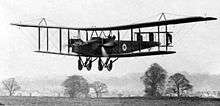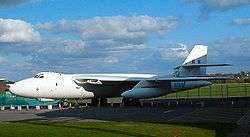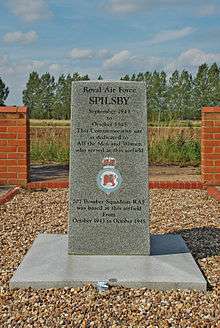No. 207 Squadron RAF
| No. 207 Squadron RAF | |
|---|---|
| Active |
31 December 1916 (RNAS) – 20 January 1920 1 February 1920 – 19 April 1940 1 November 1940 – 1 March 1950 4 June 1951 – 27 March 1956 1 April 1956 – 1 May 1965 3 February 1969 – 30 June 1984 12 July 2002 – 13 January 2012[1][2][3] |
| Country |
|
| Branch |
|
| Role |
Bomber Communications Training |
| Nickname(s) |
"Black Cat Squadron" (WW1) "City of Leicester" (After 1939) |
| Motto(s) |
Latin: Semper paratus ("Always prepared")[4] |
| Battle honours |
Western Front, 1916–1918 Ypres, 1917* Somme, 1918* Amiens Hindenburg Line* Biscay Ports, 1941–1945 German Ports, 1941–1945* Berlin, 1941–1945* Ruhr, 1941–1945* Baltic 1941–1945 Fortress Europe 1941–1944 France & Germany, 1944–1945* Normandy, 1944* Honours marked with an asterisk* are those emblazoned on the Squadron Standard |
| Commanders | |
| Notable commanders |
S/Ldr. A.W. Tedder Wg Cdr V.J. Wheeler |
| Insignia | |
| Squadron Badge heraldry | A winged lion statant[4] |
| Squadron roundel |
|
| Squadron Codes |
207 (Apr 1938 – Apr 1939) NJ (Apr 1939 – Sep 1939)[5][6] EM (Nov 1939 – Mar 1950)[7][8] D (1983–1984)[9] |
No. 207 Squadron Royal Air Force was a former bomber, communications and training squadron of the Royal Air Force, most recently based at RAF Linton-on-Ouse in Yorkshire, operating Short Tucano T.1 trainer aircraft. Before the RAF was formed it was part of the Royal Naval Air Service as No. 7 Squadron.
History
Formation and World War I

No. 7 Squadron RNAS was formed from "B" Squadron of No. 4 Wing RNAS on 31 December 1916 at Petite-Synthe, France. Note that another No. 7 Squadron RNAS had been sent to East Africa in May 1916, flying Voisins and BE.2cs for seven months on reconnaissance and bombing duties until disbanding there in January 1917, when the other 7 Squadron RNAS had already been formed in France.[10][11] Thus, formed as a specialist night bomber squadron in France in December 1916, No. 7 RNAS flew its first mission there on 3 February 1917, with four Short Bombers setting out against the Brugge (Bruges) docks.[12] In April that year it re-equipped with Handley Page O/100s, using them for night raids, including attacks against rail targets and ammunition dumps during the Second Battle of Ypres.[12] The squadron split into two in July 1917, with eight O/100s forming the initial equipment of 7A Squadron, which later became 14 Squadron RNAS, while 7 Squadron continued with 10 O/100s.[13][14]
On the formation of the Royal Air Force on 1 April 1918 it became No. 207 Squadron, RAF, moving back to Netheravon in England for re-equipping with the more advanced version of the O/100, the Handley Page O/400, returning to France in July as part of 54 Wing and continuing to fly night raids against railway targets.[12] It moved to Germany as part of the Army of Occupation in January 1919, serving there until August, when it handed its aircraft to No. 100 Squadron RAF and returned to England where it disbanded on 20 January 1920 at RAF Uxbridge.[15]
Inter-war period
The squadron re-formed on 1 February 1920 at RAF Bircham Newton.[3] Its Airco DH.9As saw service in Turkey in 1922, when it was deployed to Constantinople under the command of Arthur Tedder as part of the British intervention in the Greco-Turkish War (1919–1922); the Squadron returned to England in September 1923.[12][15] It re-equipped with Fairey IIIFs in December 1927, and with the radial engined development of the IIIF, the Fairey Gordon in August 1932. In 1935, as a response to the Italian invasion of Ethiopia, it was sent to Sudan. The Gordon's Armstrong Siddeley Panther engine proved unreliable in desert conditions, however, and they were replaced with Vickers Vincents. The following year, the squadron, again re-equipped with Gordons, returned home to RAF Worthy Down, joining RAF Bomber Command. It re-equipped with Vickers Wellesleys in 1937, only for them to be replaced with Fairey Battles early the following year. Based at RAF Cottesmore, the squadron took the role of an Operational Training Unit.[16] In April 1939 the squadron was "adopted" by the City of Leicester.
Second World War

On 19 April 1940 the squadron's training role was assumed by No. 12 Operational Training Unit (OTU), allowing 207 Squadron to re-form on 1 November of that year as part of Bomber Command's No. 5 Group. At RAF Waddington, the squadrons's crews were assigned the task of introducing the ill-fated Avro Manchester into service. Later moving to RAF Bottesford, the Manchesters were replaced by the much improved Avro Lancaster in March 1942. The squadron relocated to RAF Langar on 21 September, owing to the Bottesford runway surface breaking up and needing urgent repairs. In October 1943, 207 Squadron became the first occupant of the newly opened RAF Spilsby bomber station.
The squadron was scheduled to form part of the Tiger Force against Imperial Japan. With the dropping of the atomic bombs on Hiroshima and Nagasaki the Tiger Force plans were dropped and in November 1945, No. 207 Squadron relocated to RAF Methwold in Norfolk.
Post-war
Bombing role

After moving to RAF Mildenhall in 1949 and briefly replacing the Lancaster with the Avro Lincoln, the Squadron was disbanded on 1 March 1950. Re-formed on 4 June 1951 at RAF Marham, 207 flew the Boeing Washington until March 1954, when it was replaced by the English Electric Canberra, which remained in service with the squadron until it disbanded on 27 March 1956.

On 1 April 1956 the squadron re-formed again at RAF Marham and was now equipped with the Vickers Valiant. Later that year no. 207 took part in the Suez Campaign. On 1 May 1965 the squadron disbanded with the grounding of the Valiant fleet.
Communications role

207 Squadron was re-formed on 3 February 1969 at RAF Northolt by redesignating the Strike Command Communications Squadron, which had been till 1 January 1969 the Southern Communications Squadron based at RAF Bovingdon.[17] It was equipped with Devon C.2s, Basset CC.1s and Pembroke C.1s, with the squadron first retiring the Bassets in 1974, and its last Pembroke being transferred to No. 60 Squadron in Germany in November 1975, leaving 207 with 14 Devons.[18] Detachments of the squadron were located at RAF Wyton and RAF Turnhouse. 207 Squadron was once more disbanded on retirement of the remaining Devons on 30 June 1984,[18] VP952 ending up at the RAF Museum St Athan.[19]
Training role
On 12 July 2002 one of the Flying Training Squadrons operating Shorts Tucanos at No. 1 Flying Training School, RAF Linton-on-Ouse was renumbered as No. 207 (Reserve) Squadron.[20] The squadron was later disbanded on 13 January 2012 as a result of the 2010 Strategic Defence and Security Review.[2]

Aircraft operated
| From | To | Aircraft | Version |
|---|---|---|---|
| June 1916 | January 1917 | Voisin III | 'New Type' pusher engines |
| June 1916 | January 1917 | Royal Aircraft Factory B.E.2 | |
| December 1916 | December 1916 | Caudron G.4 | |
| December 1916 | April 1917 | Sopwith 1½ Strutter | Type 9700 Bomber |
| December 1916 | June 1917 | Short Bomber | |
| April 1917 | April 1918 | Handley O/100 | |
| April 1918 | August 1919 | Handley O/400 | |
| February 1920 | December 1927 | de Havilland DH.9A | |
| December 1927 | September 1932 | Fairey III | F |
| September 1932 | April 1936 | Fairey Gordon | Mk.I |
| April 1936 | August 1936 | Vickers Vincent | Mk.I |
| August 1936 | August 1937 | Fairey Gordon | Mk.I |
| August 1937 | April 1938 | Vickers Wellesley | |
| April 1938 | April 1940 | Fairey Battle | |
| July 1939 | April 1940 | Avro Anson | Mk.I |
| November 1940 | March 1942 | Avro Manchester | Mk.I |
| July 1941 | August 1941 | Handley Page Hampden | Mk.I |
| March 1942 | August 1949 | Avro Lancaster | Mk.I |
| May 1943 | December 1947 | Avro Lancaster | Mk.III |
| August 1949 | March 1950 | Avro Lincoln | B.2 |
| July 1951 | March 1954 | Boeing Washington | B.1 |
| March 1954 | March 1956 | English Electric Canberra | B.2 |
| July 1956 | February 1965 | Vickers Valiant | B.1 |
| February 1969 | July 1974 | Beagle Basset | CC.1 |
| February 1969 | March 1977 | Percival Pembroke | C.1 |
| February 1969 | February 1984 | de Havilland Devon | C.2 |
| July 2002 | January 2012 | Short Tucano | T.1 |
Squadron bases

| From | To | Base | Remark |
|---|---|---|---|
| June 1961 | 12 January 1917 | Kondoa Irangi, Tanganyika | 1st no. 7 RNAS |
| 31 December 1916 | 4 April 1917 | Petite-Synthe, France | 2nd no 7 RNAS |
| 4 April 1918 | 22 April 1918 | Coudekerque, France | 1 April 1918 as No. 207 Squadron RAF |
| 22 April 1918 | 13 May 1918 | RAF Netheravon, Wiltshire | |
| 13 May 1918 | 7 June 1918 | RAF Andover, Hampshire | |
| 7 June 1918 | 26 October 1918 | Ligescourt, France | |
| 26 October 1918 | 1 December 1918 | Estrées-en-Chaussée, France | |
| 1 December 1918 | 1 January 1919 | Carvin, France | |
| 1 January 1919 | 10 May 1919 | Merheim, Germany | |
| 10 May 1919 | 23 August 1919 | Hangelar, Germany | Present Bonn-Hangelar airfield |
| 23 August 1919 | 8 October 1919 | RAF Tangmere, West Sussex | |
| 8 October 1919 | 16 January 1920 | RAF Croydon, Surrey | |
| 16 January 1920 | 20 January 1920 | RAF Uxbridge, Middlesex | |
| 1 February 1920 | 29 September 1922 | RAF Bircham Newton, Norfolk | |
| 29 September 1922 | 11 October 1922 | en route to Turkey | |
| 11 October 1922 | 22 September 1923 | San Stephano, Turkey | |
| 22 September 1923 | 3 October 1923 | en route to UK | |
| 3 October 1923 | 7 November 1929 | RAF Eastchurch, Kent | |
| 7 November 1929 | 4 October 1935 | RAF Bircham Newton, Norfolk | |
| 4 October 1935 | 20 October 1935 | en route to Sudan | |
| 20 October 1935 | 28 October 1935 | Port Sudan, Sudan | |
| 28 October 1935 | 6 April 1936 | Ed Damer, Sudan | |
| 6 April 1936 | 14 August 1936 | Gebeit, Sudan | |
| 14 August 1936 | 29 August 1936 | en route to UK | |
| 29 August 1936 | 20 April 1938 | RAF Worthy Down, Hampshire | |
| 20 April 1938 | 24 August 1939 | RAF Cottesmore, Rutland | |
| 24 August 1939 | 9 December 1939 | RAF Cranfield, Bedfordshire | |
| 9 December 1939 | 5 April 1940 | RAF Cottesmore, Rutland | |
| 5 April 1940 | 19 April 1940 | RAF Cranfield, Bedfordshire | Merged here into no. 12 OTU |
| 1 November 1940 | 17 November 1941 | RAF Waddington, Lincolnshire | |
| 17 November 1941 | 20 September 1942 | RAF Bottesford, Leicestershire | Det. at RAF Syerston, Nottinghamshire 24 August 1942 |
| 20 September 1942 | 12 October 1943 | RAF Langar, Nottinghamshire | |
| 12 October 1943 | 30 October 1945 | RAF Spilsby, Lincolnshire | |
| 30 October 1945 | 29 April 1946 | RAF Methwold, Norfolk | |
| 29 April 1946 | 8 November 1946 | RAF Tuddenham, Suffolk | |
| 8 November 1946 | 28 February 1949 | RAF Stradishall, Suffolk | |
| 28 February 1949 | 1 March 1950 | RAF Mildenhall, Suffolk | |
| 4 June 1951 | 27 March 1956 | RAF Marham, Norfolk | Washington-Canberra period |
| 1 April 1956 | 1 May 1965 | RAF Marham, Norfolk | Vickers Vailant period |
| 3 February 1969 | 30 June 1984 | RAF Northolt, Middlesex | Dets. at RAF Wyton, Cambridgeshire and RAF Turnhouse, Edinburgh |
| 12 July 2002 | 13 January 2012[2] | RAF Linton-on-Ouse, Yorkshire |
See also
References
- Notes
- 1 2 3 Jefford 2001, pp. 71–72.
- 1 2 3 Dave, Allport (14 January 2012). "207 (Reserve) Squadron Disbands". key.aero. Retrieved 15 January 2012.
- 1 2 RAF – 207 Squadron". Royal Air Force. Retrieved 5 April 2010.
- 1 2 Halley 1988, p. 268.
- ↑ Bowyer and Rawlings 1979, p. 13.
- ↑ Flintham and Thomas 2003, p. 51.
- ↑ Bowyer and Rawlings 1979, p. 35.
- ↑ Flintham and Thomas 2003, p. 70.
- ↑ Flintham and Thomas 2003, p. 198.
- ↑ Hamlin 1999, p. 10.
- ↑ Jefford 2001, p. 71.
- 1 2 3 4 Rawlings 1961, p. 19.
- ↑ Robertson 1933, p. 1023.
- ↑ Halley 1980, p. 217.
- 1 2 "RAF History – Bomber Command 60th Anniversary:No. 207 Squadron". Royal Air Force. 2004. Retrieved 5 April 2010.
- ↑ Rawlings 1961, pp. 19–20.
- ↑ Hamlin 1999, p. 166.
- 1 2 Burney 1984, p. 411.
- ↑ Hamlin 1999, p. 172.
- ↑ Squadron Genealogy
- ↑ Hamlin 1999, pp. 207–219.
- ↑ Hamlin 1999, p. 190.
- Bibliography
- Aitken, Flt.Lt. W.M. (ed.) A History of No.207 Squadron – the First 68 Years. 207 Squadron RAF, 1984.
- Bewsher, Paul. Green Balls: the Adventures of a Night Bomber. Greenhill Books, 1986. ISBN 0-947898-50-6. (reprint of William Blackwood 1919 edition).
- Bowyer, Michael J.F. and John D.R. Rawlings. Squadron Codes, 1937–56. Cambridge, UK: Patrick Stephens Ltd., 1979. ISBN 0-85059-364-6.
- Burney, Allan. "Devon Demob". Aircraft Illustrated, September 1984, Vol 17 No 9. pp. 407–411. ISSN 0002-2675.
- Dick, David. 207 Squadron Memorial Book. 207 Sqn RAF Association, 1993.
- Flintham, Vic and Andrew Thomas. Combat Codes: A full explanation and listing of British, Commonwealth and Allied air force unit codes since 1938. Shrewsbury, Shropshire, UK: Airlife Publishing Ltd., 2003. ISBN 1-84037-281-8.
- Goodwin, Barry and Raymond Glynne-Owen. 207 Squadron: RAF Langar, 1942–1943. Langar Airfield, York, UK: Quacks Books/207 Squadron Memorial Committee, 1994. ISBN 0-948333-41-3.
- Halley, James J. The Squadrons of the Royal Air Force. Tonbridge, Kent, UK: Air Britain (Historians) Ltd., 1980. ISBN 0-85130-083-9.
- Halley, James J. The Squadrons of the Royal Air Force & Commonwealth, 1918–1988. Tonbridge, Kent, UK: Air Britain (Historians) Ltd., 1988. ISBN 0-85130-164-9.
- Hamlin, John F. Always Prepared – The History of 207 Squadron RAF. Tunbridge Wells, Kent, UK: Air-Britain (Historians) Ltd., 1999. ISBN 0-85130-285-8.
- Jefford, Wing Commander C.G., MBE, BA, RAF(Retd.). RAF Squadrons, a Comprehensive record of the Movement and Equipment of all RAF Squadrons and their Antecedents since 1912. Shrewsbury, Shropshire, UK: Airlife Publishing, 1988 (second edition 2001). ISBN 1-85310-053-6.
- Laing, John A. The Washington Era: Marham June 1951 to March 1954. Perth, Scotland: Self-published, 1998.
- Moyes, Philip J.R. Bomber Squadrons of the RAF and their Aircraft. London: Macdonald and Jane's (Publishers) Ltd., 2nd edition 1976. ISBN 0-354-01027-1.
- Rawlings, John D.R. "Squadron Histories: No.207". Air Pictorial, January 1961. Vol. 23, No. 1, pp. 19–20.
- Robertson, F. A. de V. "No. 207 (Bomber) Squadron". Flight, 12 October 1933, pp. 1022–1024.
- Wynn, Humphrey. Darkness Shall Cover Me: Night Bombing over the Western Front, 1918. Shrewsbury, Shropshire, UK: Airlife Publishing, 1989. ISBN 1-85310-065-X.
- (also published as The Black Cat Squadron: Night Bombing in World War I). Washington, D.C.: Smithsonian Institution Press, 1990. ISBN 0874749921
External links
| Wikimedia Commons has media related to No. 207 Squadron RAF. |
- RAF Spilsby history
- 207 Squadron RAF Association website
- Squadron history on RAF website
- Histories -and more- of nos. 206–210 sqn on RAFweb
- Lancaster ED627, EM-N of 207 Squadron RAF
